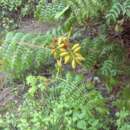en
names in breadcrumbs


Guilandina bonduc, commonly known as grey nicker, nicker bean,[3] fever nut[4] or knicker nut, is a species of flowering plant in the senna tribe, Caesalpinieae,[2] that has a pantropical distribution.[5] It is a liana that reaches a length of 6 m (20 ft) or more and scrambles over other vegetation. The stems are covered in curved spines.[6] Its 2 cm (0.8 in) grey seeds,[7] known as nickernuts,[8] are buoyant and durable enough to be dispersed by ocean currents.[5]
Guilandina bonduc grows as a climber, up to 8 m (30 ft) long or as a large sprawling shrub or small shrubby tree. The stems are irregularly covered with curved prickles. The leaves are large and bi-pinnate, up to 40 cm (16 in) long with scattered prickles on the rachises and blades. There are four to eleven pairs of pinnae, 5 to 20 cm (2 to 8 in) long with five to ten pairs of pinnules. The pinnules are 15 to 40 mm (0.6 to 1.6 in) long, elliptic, oblong or ovate with acute tips and entire margins. The inflorescence is an axillary raceme, often branched, covered with short hairs and up to 15 cm (6 in) long. The jointed pedicels are up to 6 mm (0.2 in) long. The sepals are shorter than the petals which are around 10 mm (0.4 in) long; the petals are yellow, sometimes with a spot of orange near the base of the keel. The flowers are followed by large, flattish, spiny green pods which later turn brown, some 9 by 4 cm (4 by 2 in), containing one or usually two, glossy, rounded, grey seeds.[3][9]
Guilandina bonduc has a pantropical distribution. It typically grows near the coast, in scrub, on sand dunes and on the upper shore.[10] It also occurs inland, in lowland secondary forest and disturbed areas near villages; this may be the result of the seed being accidentally dropped after being transported for medical purposes or for use as counters in board games. The seeds are buoyant and retain their viability in both fresh and sea water, enabling them to disperse to new coastal locations.[11] When washed up on the shore, they are sometimes known as sea pearls.[12]
Nodules on the plant's roots contain symbiotic bacteria that fixes nitrogen. This is used as a nutrient by the vine and also benefits other plants growing in close proximity.[11]
This plant has been used in traditional medicine. The seeds have tonic and antipyretic properties and the bark and leaves have been used to lower fevers. An oil extracted from the seeds has been used in cosmetics and for treating discharges from the ear.[4]
 Guilandina bonduc leaves
Guilandina bonduc leaves Guilandina bonduc, commonly known as grey nicker, nicker bean, fever nut or knicker nut, is a species of flowering plant in the senna tribe, Caesalpinieae, that has a pantropical distribution. It is a liana that reaches a length of 6 m (20 ft) or more and scrambles over other vegetation. The stems are covered in curved spines. Its 2 cm (0.8 in) grey seeds, known as nickernuts, are buoyant and durable enough to be dispersed by ocean currents.
 Pods and seeds
Pods and seeds